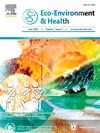Can oxidative potential be a plant risk indicator for heavy metals contaminated soil? Analysis of ryegrass (Lolium perenne L.) metabolome based on machine learning
引用次数: 0
Abstract
Evaluating the plant risk of soil pollution by plant physiological indices usually requires a long cycle and has significant uncertainty. In this study, oxidative potential (OP) of the in situ heavy metal contaminated soils was measured by the dithiothreitol method. The oxidative stress response of the model plant ryegrass (Lolium perenne L.) induced by heavy metal contaminated soil was evaluated by the biomarkers, including superoxide dismutase and total antioxidant capacity. The comprehensive biomarker response index has a significant exponential correlation with the OP of soil (r = 0.923, p < 0.01) in ryegrass. Metabolomics analysis also showed a significant relationship of the metabolic effect level index of amino acids and sugars with OP. Random forest was selected from four machine learning models to screen the metabolites most relevant to OP, and Shapley additive explanations analysis was used to explain the contribution and the influence direction of the features on the model. Based on the selected 20 metabolites, the metabolic pathways most related to OP in plants, including alkaloid synthesis and amino acids metabolism, were identified. Compared to the plant physiological indices, OP is a more stable and faster indicator for the plant risk assessment of heavy metals contaminated soil.

氧化电位可以作为重金属污染土壤的植物风险指标吗?基于机器学习的黑麦草代谢组分析
利用植物生理指标评估土壤污染的植物风险通常需要较长的周期,且具有较大的不确定性。采用二硫代苏糖醇法测定了原位重金属污染土壤的氧化电位。采用超氧化物歧化酶和总抗氧化能力等生物标志物评价了模式植物黑麦草(Lolium perenne L.)在重金属污染土壤下的氧化应激反应。综合生物标志物响应指数与土壤有机肥呈显著指数相关(r = 0.923, p <;0.01)。代谢组学分析也显示氨基酸和糖的代谢效应水平指数与OP之间存在显著关系。我们从四个机器学习模型中选择随机森林筛选与OP最相关的代谢物,并使用Shapley加性解释分析来解释特征对模型的贡献和影响方向。根据选取的20种代谢物,确定了植物中与OP最相关的代谢途径,包括生物碱合成和氨基酸代谢。相对于植物生理指标,OP是重金属污染土壤植物风险评价的更稳定、更快的指标。
本文章由计算机程序翻译,如有差异,请以英文原文为准。
求助全文
约1分钟内获得全文
求助全文
来源期刊

Eco-Environment & Health
环境科学与生态学-生态、环境与健康
CiteScore
11.00
自引率
0.00%
发文量
18
审稿时长
22 days
期刊介绍:
Eco-Environment & Health (EEH) is an international and multidisciplinary peer-reviewed journal designed for publications on the frontiers of the ecology, environment and health as well as their related disciplines. EEH focuses on the concept of “One Health” to promote green and sustainable development, dealing with the interactions among ecology, environment and health, and the underlying mechanisms and interventions. Our mission is to be one of the most important flagship journals in the field of environmental health.
Scopes
EEH covers a variety of research areas, including but not limited to ecology and biodiversity conservation, environmental behaviors and bioprocesses of emerging contaminants, human exposure and health effects, and evaluation, management and regulation of environmental risks. The key topics of EEH include:
1) Ecology and Biodiversity Conservation
Biodiversity
Ecological restoration
Ecological safety
Protected area
2) Environmental and Biological Fate of Emerging Contaminants
Environmental behaviors
Environmental processes
Environmental microbiology
3) Human Exposure and Health Effects
Environmental toxicology
Environmental epidemiology
Environmental health risk
Food safety
4) Evaluation, Management and Regulation of Environmental Risks
Chemical safety
Environmental policy
Health policy
Health economics
Environmental remediation
 求助内容:
求助内容: 应助结果提醒方式:
应助结果提醒方式:


